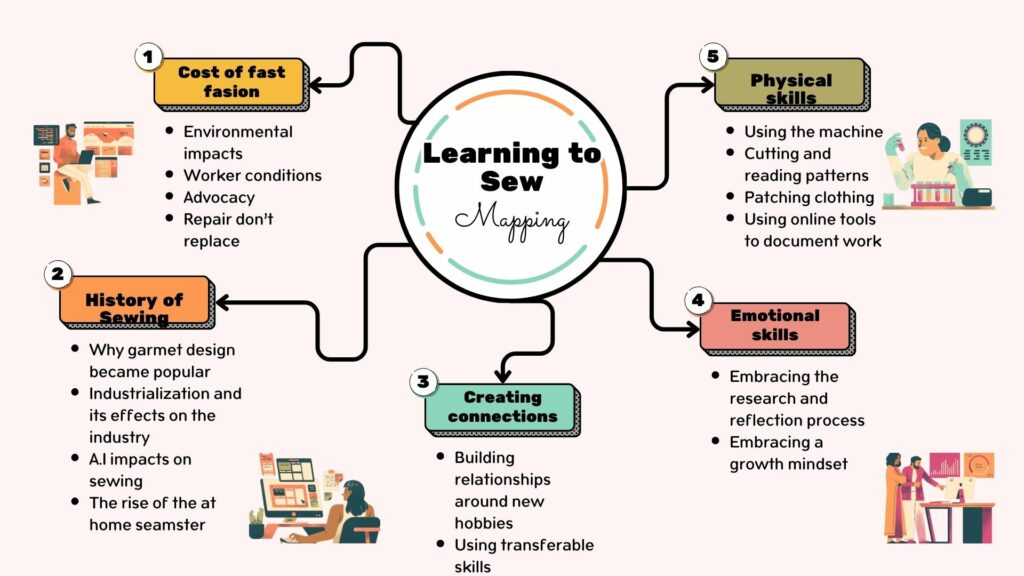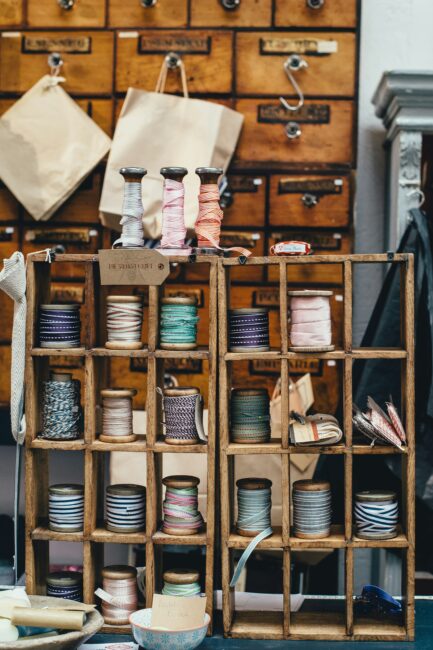My journey through the free inquiry has been filled with curiosity, excitement, determination, and setbacks. However, the process has been fulfilling. Reflecting on that process, I think it’s important to cover four aspects of the project: where I started, what I learned, how to apply those skills, and what the future holds.
Where I Started
Before this project, I wouldn’t have considered making time to learn to sew. As far as new hobbies or skills, I would have put them in the category of “Oh, that looks interesting. I’ll invest my time in that later.” but when does “later” come? Tomorrow is something we frequently tell ourselves will be there to learn a new hobby or call a friend. The truth is tomorrow is uncertain and never really arrives. One thing I do make time in my life for is work. Whether it’s work for compensation, school, work for friends, work on the house or the yard, work takes a front seat in my life. So, framing my sewing project not as something I wanted to do but as something I was required to do gave me the ambition to get started. Before this project, my knowledge was nothing more than some liked fashion videos on TikTok and the guilty pleasure of loving the film “The Devil Wears Prada” (Iconic). Garment design and construction have always been fascinating to me. However, I never thought my skills could be applied to learn the trade. Sewing always seemed just outside the realm of possibility. Plus, I had other hobbies. Part of me thought I needed more time for something new. I already enjoy many hobbies, so if I have free time, that’s where my focus should be. Well, I believe there is some truth to that. What I wasn’t factoring in was personal growth. I haven’t failed at something in a long time. Most projects I take on are adjacent enough to my current skills that I can be moderately successful immediately. While this is satisfying, it’s also very stifling. Feeling uncomfortable and trying new things is where people learn to grow and change. Connecting this thought to education, how can I expect my students to try new and different things if I don’t when presented with the opportunity? It was this thought that helped me persevere through the project.
What I Learned

My free inquiry project started with “Learn to sew.” On the surface, this seems like a simple prompt; however, because I approached it as work, it took on a life of its own. I had to ask myself questions like, why is this important to me? Why is this an important skill at all? Who benefits from this project? Why are clothes made? Is fashion ethical? Is clothing manufacturing ethical? You get the Idea. (The answers are: Owning cheap attractive clothes, repairing is better than replacing, me and the environment, for money, most times no, and rarely). However, asking these questions led to an inquiry into adjacent fields of sewing, such as fast fashion and the history of patterns. This process and the cultivation of curiosity by having to create a blog post every week strengthened my understanding of the field and allowed me to make a personal connection to it. That connection will keep me pursuing this hobby long after this project resolves. Moving on from the inquiry portion of the assignment, what did I learn that’s more tangible? I can sew a patch, thread a machine, and do many different stitch patterns, including straight stitch, box stitch, and stay stitch. I can read and follow a patternand pick appropriate material for projects (this last one we could leave in the “needs improvement “column).
The free inquiry project was also something that was required to be documented online. This meant creating a Blog, making weekly posts, and becoming familiar with online tools. In my personal practice, I would never have done this. Under normal circumstances, when I take on a project, I just continuously work at it until it’s complete. Most of the planning and reflection takes place in my head, and for the most part, that process has proven effective. Previously, documenting work online through a blog or social media seemed reductive. Why add extra steps? Isn’t the goal to be as efficient as possible? Through this process, I learned that creating a space for curiosity and exploring thoughts and feelings about a project can be as fulfilling as the project itself. I have enjoyed the physical process of learning the skill of sewing and the reflective process of exploring all the questions I have had about the subject.
How to Apply those Skills.
When discussing the application of skills for this project, there are two categories: mechanical skills and emotional skills. Mechanical skills are the skills I developed during the assignment that can be physically performed now that they have been learned. This category contains skills like threading the machine and sewing a garment physically. These skills can be applied by planning a project or taking a garment that has been damaged and fixing it. In the future, I’ll use my sewing to mend my clothing and my friends’ clothes, and one day, I’ll make clothes as gifts. The second category emotional learning is for me is defined as a shift in my own teaching pedagogy or my approach to future learning and education. This category includes being more inclined to take on new hobbies that I need to be more comfortable with and using technology to help teach and share those ideas. Emotional learning is where I had the most growth in this project. Learning this hobby helped me embrace the concept of a growth mindset by constantly failing but being invested more in making it to the final goal than day-to-day setbacks. In my future processes for learning a new skill, I’ll keep a journal and document my ideas, questions I want answered in the future, and connections for research.
What the future holds
Overall, the project was a success. The connections I made to the skill of becoming a Taylor have created a lasting passion for me to continue learning about the skill and its history. Currently, I’m working on building a small sewing space and collecting materials to help me with my hobby. I ordered a new Singer sewing machine, which my wife and her mother helped me pick out, and power cutters. I frequently check the thrift store for new patterns for garments. I have also started asking for more minor sewing things for gifts for Christmas and birthdays, like pincushions, small scissors, etc. Learning about this hobby has connected me to a number of the women in my life as well. Bonding with my sewing partner, Anne, was a great experience. Furthermore, I have started discussing projects with my wife and her mother, both great seamstresses. I hope that by the end of the year, I’ll be able to complete some smaller projects that will scaffold me up to finish the hoodie I had initially planned on finishing so that I can wear it and be proud of the creation.
